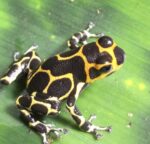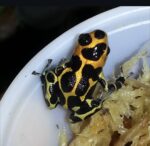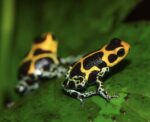Description
ranitomeya imitator intermedius (formerly Dendrobates imitator), is a species of poison dart frog found in the north-central region of eastern Peru. Its common names include mimic poison frog and poison arrow frog, and it is one of the best known dart frogs.
It was discovered in the late 1980s by Rainer Schulte who later split it up into more subspecies; describing each as a specific color morph, and sometimes having a separate behavioral pattern. The acoustics, morphs, and behavior of the species have been extensively researched.
Habitat of ranitomeya imitator intermedius
This frog has been found in primary and old-growth secondary rainforests between 200 and 1200 meters above sea level. This frog is diurnal, with two periods of activity, one early in the day and one later.
The male frogs are territorial, and will attack other males that enter their range. Generally, the frog chooses one good plant to retreat to and works from there. Mated pairs have closely overlapping ranges.
Diet of ranitomeya imitator intermedius for sale
Ranitomeya Imitator Intermedius eat ants, mites, and other invertebrates, such as flies, beetles, and springtails.
Color morphology of ranitomeya imitator intermedius

Among different populations of, different color morphs are present to mimic other poison frog species. There are four color morphs among R. imitator populations that mimic closely related sympatric (existing in the same area) species: varadero (R. fantastica), striped (lowland R. variabilis), spotted (highland R. variabilis), and banded (R. summersi).
The geographic distribution of these morphs primarily includes geographically isolated populations in different areas of Peru, however there are a number of “transition zones” between populations where different color morphs interact.
The striped morph is the most widely spread, mimicking the striped Ranitomeya variabilis and can be found throughout the lower Huallaga River drainage in Peru. The spotted morph mimics the highland spotted frog Ranitomeya variabilis with mainly blue-green coloration, but can be found in other forms, sometimes in yellow.
Although R. imitator closely resembles R. variabilis in coloration with its striped morph, the two species differ in many key aspects. R. imitator provides biparental care and is a monogamous species, while R. variabilis provides solely paternal care and is polygamous.
The aradero morph is a lowland form that lives nearby another but does not resemble it. Last, the banded morph, a mimic of Ranitomeya summersi, lives in much drier climates than the average R. imitator and is most often found in Dieffenbachia and Heliconia plants.
Interactions between different morphs of Ranitomeya imitator Yumbatos
While populations of different color morphs are concentrated in different areas of Peru, there are transition zones between populations where different color morphs may interact.
These transition zones have been particular areas of interest to study reproductive isolation and incipient speciation, and recent research suggests that color pattern is likely a driving factor in reproductive isolation, as some transition zones show evidence of assortative mating, where individuals of one morph prefer to mate with others of the same morph.
Mating calls by males are an important factor in mating, and often need to be distinct in order to attract females of the same species. In R. imitator, male calls vary little among different color morphs, however it has been suggested that color pattern is the principal component that drives speciation.
























Reviews
There are no reviews yet.